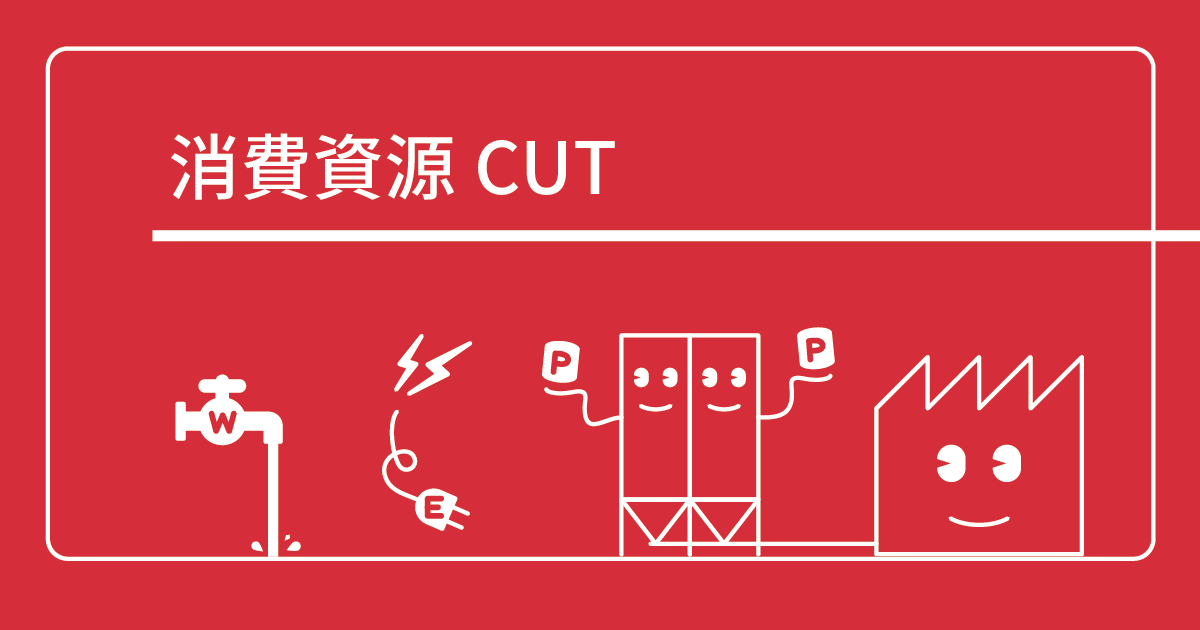Aiming for factor4 of molding factories
Achieving stable production through water quality control of cooling towers and cooling water.
2023.02.08
At your factory, as time passed, molding defects such as sink marks and warpage began to occur during the production of molded products. Have you ever had the experience of being lost?
These may be caused by deterioration of the cooling water quality, resulting in a drop in cooling efficiency. Continuing to use cooling water whose quality has deteriorated may lead to equipment failure. Therefore, quality control of cooling towers and cooling water is essential for continuous and stable production.
In this article, we will specifically introduce the mechanism of molding defects and troubles, and how to manage water quality, from improving water quality to maintaining water quality.
Problems caused by deterioration of cooling water quality and their causes
The role of factory water in molding includes cooling and temperature control of molding machines and molds, and cooling of other equipment. Water is indispensable for cooling and temperature control in a molding factory, but if the quality of the cooling water deteriorates, it will lead to problems such as molding defects and equipment failure.
Molding defects here mainly refer to phenomena such as sink marks and warpage that deform the molded product after molding. Good products were obtained under the conditions when molding was started, but deformation defects increased with the passage of time. In the situation where adjusting the molding conditions to obtain good products = lengthening the cooling time, it is highly likely that the cooling efficiency has decreased.
So why does the cooling efficiency drop that causes these troubles?
Why does the cooling efficiency decrease?
Deterioration of cooling water quality does not immediately lead to a decrease in cooling efficiency. Deterioration of cooling water quality is actually caused by the concentration of various components such as silicic acid (silica/lime), calcium, and magnesium in the water over time. As a result of forming a film, the heat exchange efficiency with the temperature controlled object decreases = the cooling efficiency decreases.

Since this symptom progresses gradually, it takes time to become visible, such as a decrease in productivity due to molding defects or changes in molding conditions, and it is overlooked because sudden changes do not occur. , is an issue that tends to be postponed for fundamental measures.
Another question may have arisen here. I wrote that the deposition of scale is caused by the concentration of components in the water, but in the next chapter, I will explain why the components are concentrated and the mechanism behind this.
Why does concentration of ingredients in water occur?
Cooling towers used to supply cooling water for factory are called open cooling towers, which are used in many factory because they are inexpensive and require little space. If you are working in a factory, you must have seen cooling towers installed on the premises and buildings at least once. Wasn't white smoke billowing up from the top?
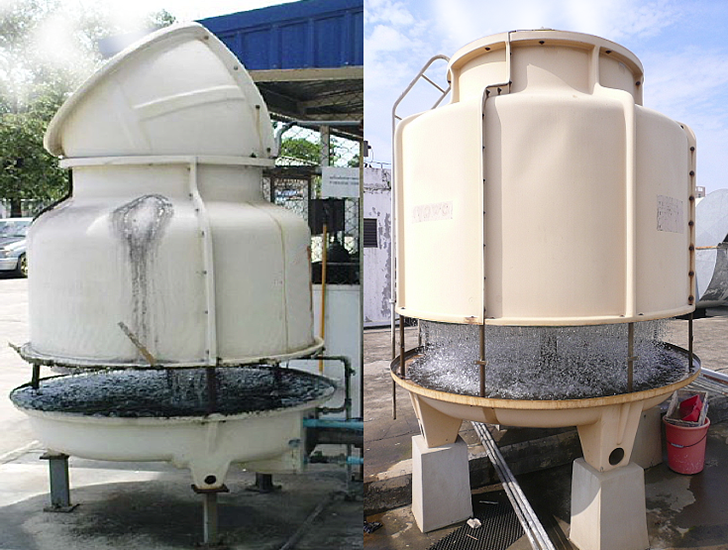
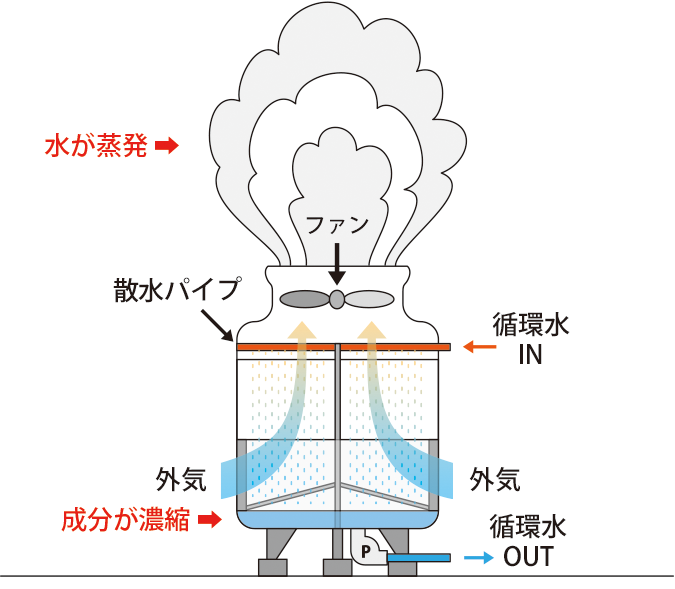
In an open cooling tower, circulating water is sprayed inside the tower, and a fan is used to expose the water directly to outside air, which evaporates some of the water for cooling. That's how it was. Since only water evaporates, the ingredients contained in the water remain in the cooling tower. New water is added to make up for the moisture lost through evaporation, and this cycle gradually concentrates the ingredients. In addition, airborne dust and plant spores are mixed in with the outside air, further deteriorating water quality.
Another problem is that the metal exposed to the outside air easily rusts, and the cooling water that touches it carries the rust to other equipment in the same route, causing rust to occur. If left unattended, it will adversely affect various devices.
If you can understand the contents so far, it will be too late if troubles due to deterioration of water quality appear in a visible form! You can easily imagine that. Therefore, in order to continue stable production, it can be said that it is essential to manage the water quality to maintain the initial state so that the quality of the cooling water does not deteriorate in advance.
Specific methods for improving and maintaining water quality
The main measures to improve and maintain water quality are as follows.
- Adjust the quality of cooling water
- Remove concentrated components in cooling water
- Cleaning water pipes with precipitation hardening of scale
- Prevents deterioration of water quality from the source
We will introduce items that realize each content.
Adjust the quality of cooling water
Cooling water conditioner "CALFA BAS" prevents scale from depositing inside pipes by aggregating and removing scale in water (*).

Since all the ingredients are made from inorganic substances, there is no need for post-treatment, and even if it is discharged directly into the wastewater, it will not adversely affect the environment. Safety and functionality meet EU standards. In addition, since it creates a rust-preventive film on the metal surface, a strong rust-preventive effect can be expected.
*Since CALFA BAS alone can aggregate scale in water, it is necessary to use a filter to remove this. Also, since a lot of aggregates are generated at the beginning of the introduction, it is necessary to clean the filter frequently.
On the other hand, we offer "Sabilene" which suppresses the generation of iron oxide to prevent the generation of red rust. Red rust occurs when iron contained in pipes is ionized, dissolved in water, and oxidized when exposed to oxygen. "Sabilene" prevents the occurrence of red rust by eluting metal ions and suppressing the ionization of iron.
Both items can be easily installed by simply placing them in the water tank on the cooling water path or in the tank inside the chiller, so you can easily try them out.
Remove concentrated components in cooling water
Installing a filter is the basic way to remove suspended solids and concentrated components in water, but the most recommended one is the filterless filter "CALFA SEP ( calfacep)”. The RINGS high-speed separation method, which uses the world's first specially shaped ring (patented), separates and removes any component that is heavier than water (specific gravity of 1.0 or more).
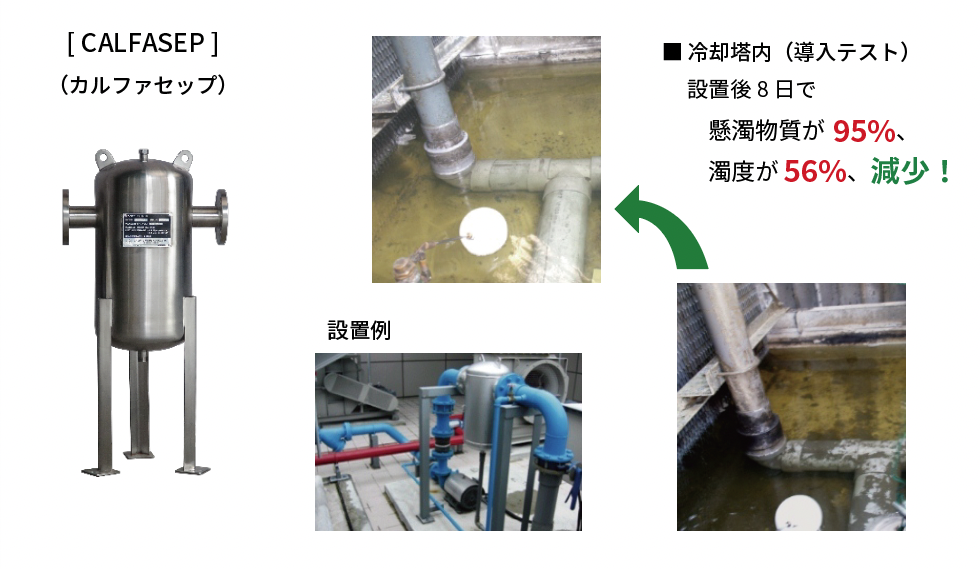
Other features include the ability to separate ultra-fine impurities up to 7 microns with almost no pressure loss, no maintenance such as cartridge replacement or cleaning, and regular discharge of impurities accumulated under the tank. It can be used for a long time just by doing it.
Another product we recommend is the "preCLEAR" ion exchange water softener with filter, which can recover concentrated components and improve water quality at the same time. Simply install it in an existing circulation line and it not only removes suspended solids and rust from the water, but also softens the water through ion exchange and removes calcium and magnesium, which cause scale. The large and small filters and ion exchange filter need to be replaced regularly, but it does not require a power source and does not use salt or chemicals.
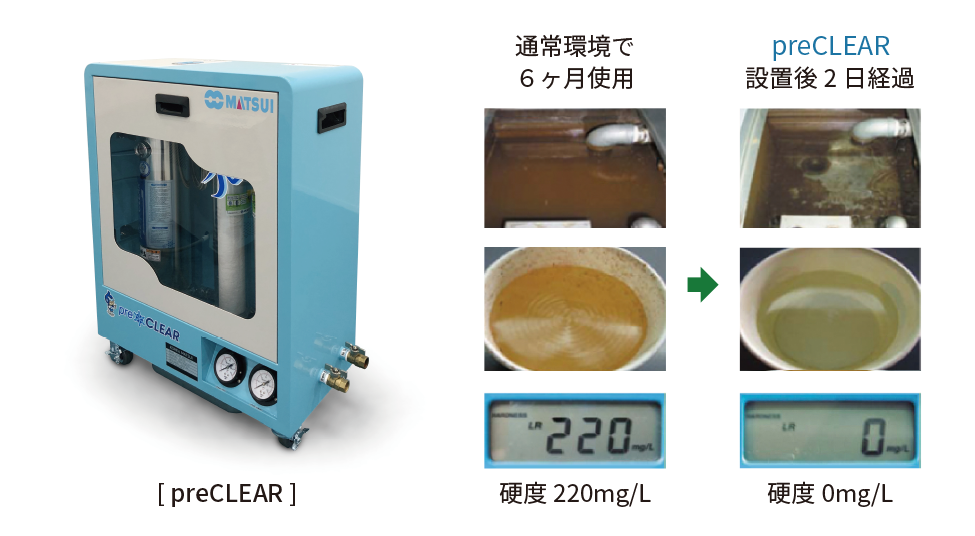
Cleaning water pipes with precipitation hardening of scale
By the time you realize the need to improve and manage water quality, you may find that scale and rust have already formed in the cooling water passages of your equipment! The low-pressure combined water flow cleaning device "Water Way" cleans the water pipes of your equipment using physical actions such as cavitation and erosion. It uses only water and air, and no chemicals, so it is environmentally friendly. After cleaning, the water can be directly discharged into factory wastewater without any special treatment (*).
*The scales and rust peeled off by washing are collected by the filter.
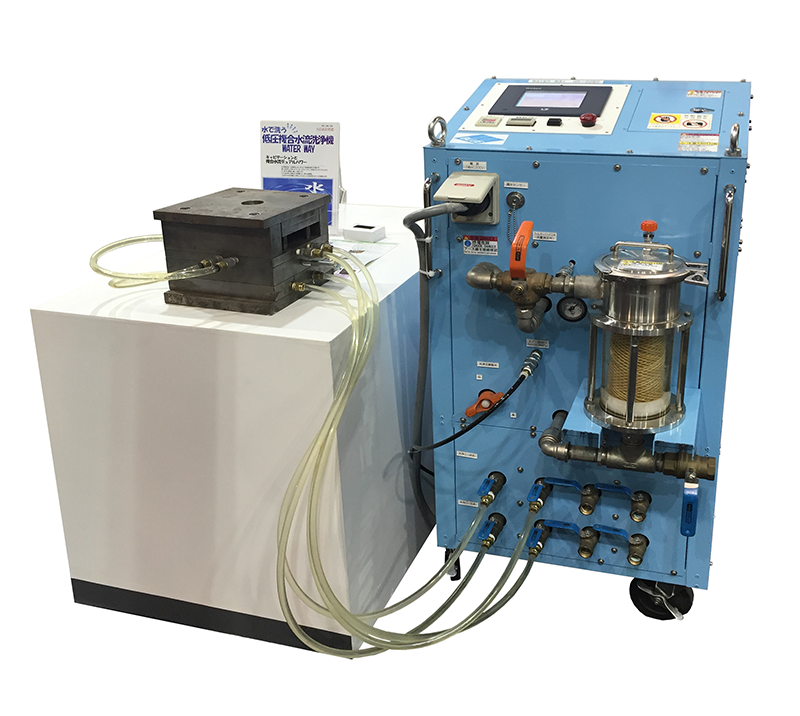
By regularly cleaning the water pipes of equipment such as molds and heat exchangers, you can maintain the initial state without clogging. It is also possible to automate cleaning and integrate equipment, which is useful for preventive maintenance.
Prevents deterioration of water quality from the source
As I mentioned earlier, the reason why the ingredients in the water in the cooling water are concentrated is because only the water evaporates. need to be reviewed. This is where the sealed cooling tower that circulates the cooling water in a closed circuit, created with the same concept as the chiller mechanism introduced in the previous chapter, was introduced.


With this method, the circulating cooling water does not evaporate, so the initial water quality is maintained for a long period of time. However, this enclosed cooling tower also has its weaknesses. The cooling water used in the factory circulates in a closed circuit, but a separate system of water is used to cool the heat exchanger. As the water evaporates here, the components are concentrated, so scales and sludge-like substances such as plant spores adhere to the outside of the heat exchanger, reducing heat exchange efficiency. Corrosion progresses, causing pinholes and cracks in the heat exchanger.
Therefore, we recommend Air Cooled Closed Type Water Cooling System" Ecobrid". This Next-generation type cooling tower not only solves these problems of water evaporation → component concentration → reduced cooling efficiency → equipment failure/damage, but also enables significant water and electricity savings.
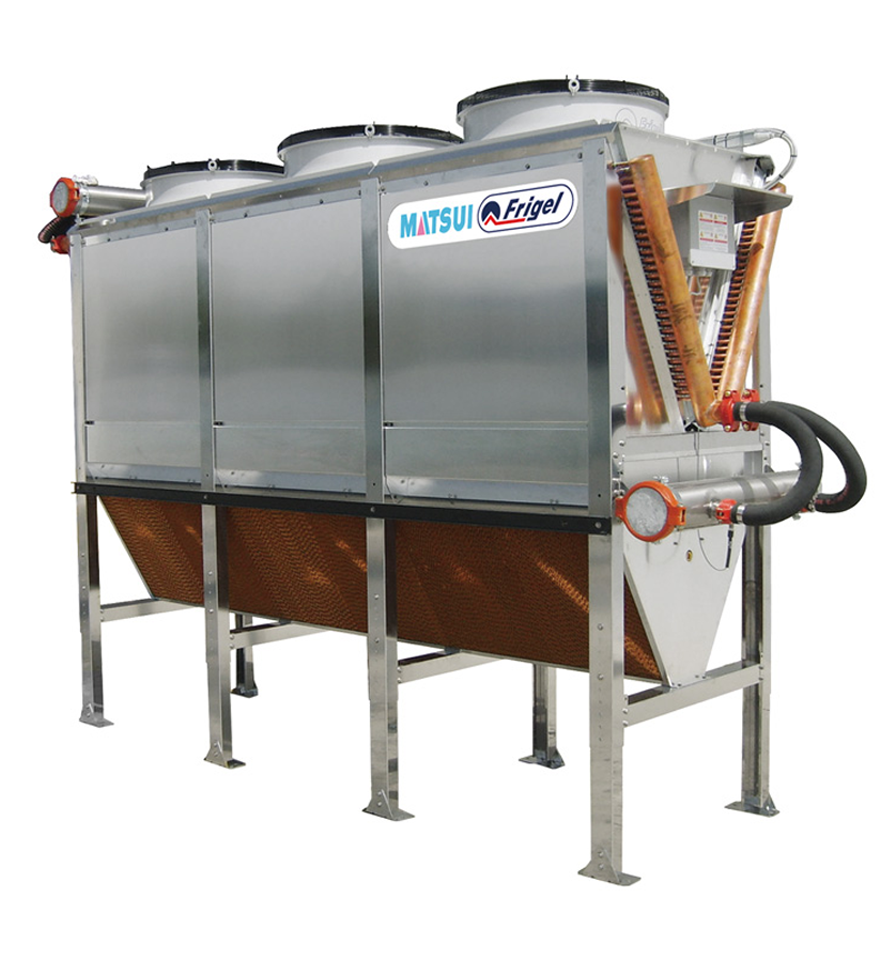
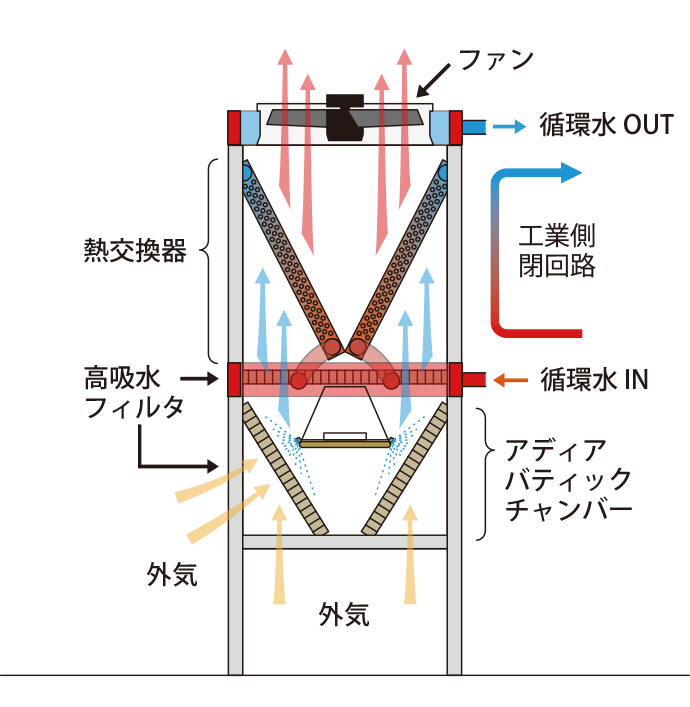
"ecobrid" cools the circulating water by passing outside air through a heat exchanger. When the outside temperature is low, the temperature will drop as it is. When the temperature rises and the outside air alone is not sufficient to cool the room, the upper fan is turned on to force the air to cool down. If the temperature rises further, tap water is sprayed on the high water absorption filter installed in the outside air passage to cool the cooling air and lower the temperature. Thanks to this mechanism, the device itself can be used for a long period of time with regular inspections and simple maintenance.
As an aside, I think it's easier to understand if you imagine this Air Cooled Closed Type Water Cooling System, a car radiator. If the temperature rises too much, the fan will rotate, and if you drive at high speed on a rainy day, rainwater will be splashed, but as you rarely need to maintain or replace the radiator, this "ecobrid" has a very long life. To do.
Compared to open and closed type cooling towers, the water saving rate is about 95% and the power saving rate is about 25%, achieving significant energy and resource savings. Furthermore, in terms of service life, compared to the 7-year design of typical cooling towers, ecobrid is designed to last 20 years, which is significantly longer. You could call it a device.
Summary
The deterioration of the cooling tower and cooling water quality progresses gradually, and it takes time for defects such as molding defects and equipment failures to appear in tangible form, making it one of the problems that are difficult to recognize. However, if water pipe clogging or equipment failure occurs, it will take time, effort, and money to recover, resulting in a significant drop in productivity.
In order to achieve long-term stable production, it is important to manage the quality of cooling water on a daily basis. Matsui proposes various solutions to improve and maintain water quality. Please feel free to contact us.


